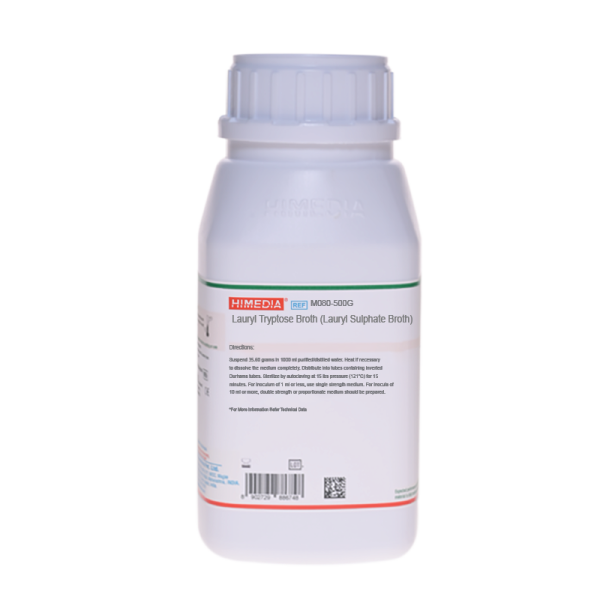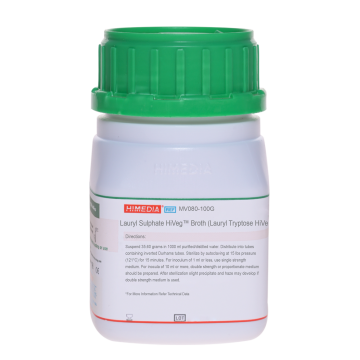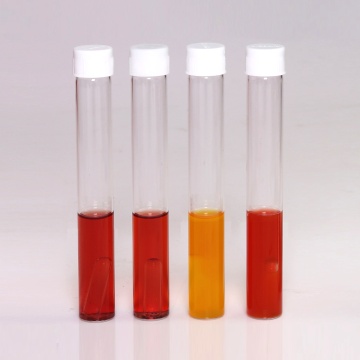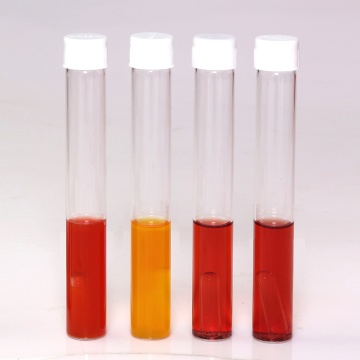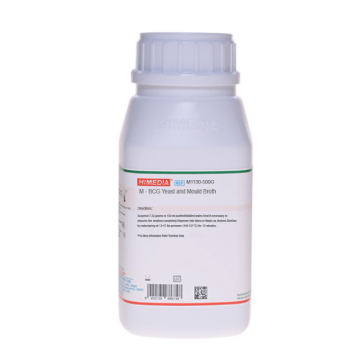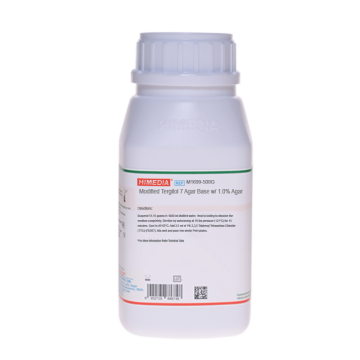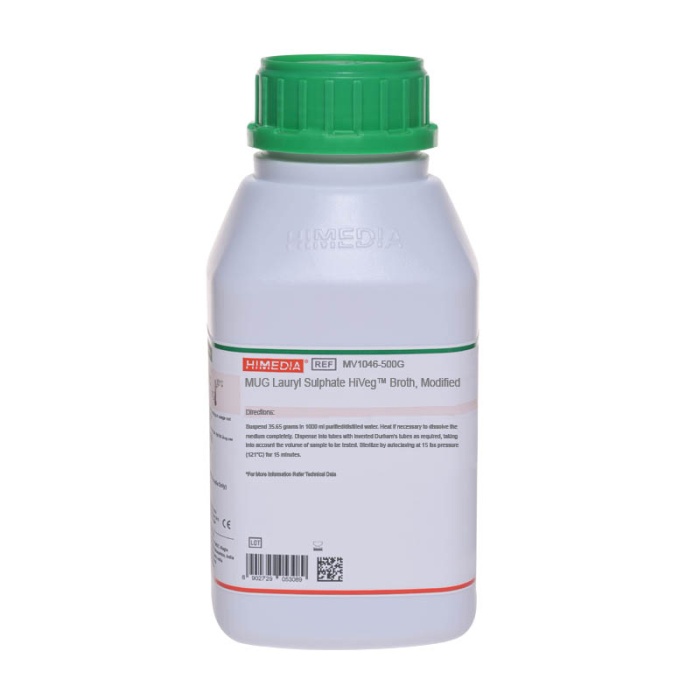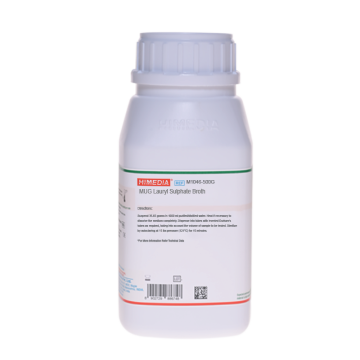 Your enquiry has been submitted
Your enquiry has been submitted
Lauryl Sulphate Broth (Lauryl Tryptose Broth)
Non selective media for Enrichment and Propagation#CC293D
Intended use
Recommended for detection and enumeration of coliform bacteria in water, waste water, dairy products,other food samples. The composition and performance criteria are as per the specification laid down in ISO 11133:2014 & Amd :2018
Composition**
| Ingredients | g/L |
|---|---|
| Tryptose | 20.000 |
| Lactose | 5.000 |
| Sodium chloride | 5.000 |
| Dipotassium hydrogen phosphate | 2.750 |
| Potassium dihydrogen phosphate | 2.750 |
| Sodium lauryl sulphate (SLS) | 0.100 |
| Final pH (at 25°C) | 6.8±0.2 |
**Formula adjusted, standardized to suit performance parameters
Directions
Suspend 35.60 gram in 1000 ml purified/distilled water. Heat if necessary to dissolve the medium completely. Distribute into tubes containing inverted Durhams tubes. Sterilize by autoclaving at 15 lbs pressure (121°C) for 15 minutes. For inoculum of 1 ml or less, use single strength medium. For inocula of 10 ml or more, double strength or proportionate medium should be prepared.
Principle And Interpretation
Coliforms are considered to be members of Enterobacteriaceae, which grow in the presence of bile salts and produce acid and gas from lactose within 48 hours at 37°C (1). These bacteria can also be defined as, members of Enterobacteriaceae capable of growing at 37°C, that normally possess β-galactosidase (2). Lauryl Sulphate Broth is used for the detection of coliforms in water, dairy products and other foods, as recommended by APHA (3-5). It can also be used for the presumptive detection of coliforms in water, effluent or sewage by the MPN test (6). Lauryl Sulphate Broth was developed by Mallmann and Darby (7). Cowls (6) demonstrated that inclusion of sodium lauryl sulphate makes the medium selective for coliform bacteria. It was later investigated that Lauryl Sulphate Broth gave a higher colon index than the confirmatory standard methods media and also that gas production in Lauryl Sulphate Broth not only acts as a presumptive test but also as a confirmatory test for the presence of coliforms, in the routine testing of water (7). Lauryl Sulphate Broth is also recommended by the ISO Committee for the detection of coliforms (8).
Lauryl Sulphate Broth is designed to obtain rich growth and substantial amount of gas from small inocula of coliform organisms. Aerobic spore-bearers are completely inhibited in this medium. Tryptose provides essential growth substances, such as nitrogen and carbon compounds, sulphate and trace ingredients. The potassium phosphates provide buffering system, while sodium chloride maintains osmotic equilibrium. Sodium lauryl sulphate inhibits organisms other than coliforms. For inoculum of 1 ml or less, use single strength medium. For inocula of 10 ml or more, double strength or proportionate medium should be prepared. After inoculation, incubate the tubes at 37°C for 24 to 48 hours. For every tube showing fermentation (primary fermentation), inoculate two tubes of Lauryl Tryptose Broth from the tube showing primary fermentation and incubate these tubes at 37°C and 44°C respectively. If there is fermentation in the tube incubated at 44°C after 8 to 24 hours, perform indole test by adding Kovacs reagent. A positive indole test in a broth tube showing gas production at 44°C indicates the presence of Escherichia coli. If no fermentation occurs in the tube incubated at 37°C after 24 hours, the primary fermentation is assumed to be due to organisms other than coliforms. Broth becomes cloudy if stored at 2-8°C, but it gets cleared at room temperature. Refer appropriate references for standard procedures (1,6,8).
Type of specimen
Food and dairy samples; Water samples
Specimen Collection and Handling:
For food and dairy samples, follow appropriate techniques for sample collection and processing as per guidelines (4,5,8).
For water samples, follow appropriate techniques for sample collection, processing as per guidelines and local standards(1,3). After use, contaminated materials must be sterilized by autoclaving before discarding.
Warning and Precautions
Read the label before opening the container. Wear protective gloves/protective clothing/eye protection/ face protection. Follow good microbiological lab practices while handling specimens and culture. Standard precautions as per established guidelines should be followed while handling specimens. Safety guidelines may be referred in individual safety data sheets.
Limitations :
- Individual organisms differ in their growth requirement and may show variable growth patterns on the medium.
- Each lot of the medium has been tested for the organisms specified on the COA. It is recommended to users to validate the medium for any specific microorganism other than mentioned in the COA based on the user's unique requirement.
Performance and Evaluation
Performance of the medium is expected when used as per the direction on the label within the expiry period when stored at recommended temperature.
Quality Control
Appearance Cream to yellow homogeneous free flowing powder
Colour and Clarity of prepared medium Light yellow coloured, clear solution without any precipitate
Reaction Reaction of 3.56% w/v aqueous solution at 25°C. pH: 6.8±0.2
pH 6.60-7.00
Cultural Response Productivity: Cultural characteristics observed after an incubation at 30 ± 1°C for 24 ± 2 to 48 ± 2 hours. Selectivity: Cultural characteristics observed after an incubation at 30 ± 1°C for 24 ± 2 to 48 ± 2 hours.
| Organism | Inoculum (CFU) | Growth | Characteristic reaction | Indole production $ at 44°C |
|---|---|---|---|---|
| Productivity | ||||
| Escherichia coli ATCC 25922 (00013*) | 50-100 | good growth with gas in Durhams tube | Gas production and turbidity | positive reaction, red ring at the interface of the medium |
| Escherichia coli ATCC 8739 (00012*) | 50-100 | good growth with gas in Durhams tube | Gas production and turbidity | positive reaction, red ring at the interface of the medium |
| Citrobacter freundii ATCC 43864 (00006*) | 50-100 | good growth with gas in Durhams tube | Gas production and turbidity | negative reaction, no colour development / cloudy ring |
| Selectivity | ||||
| Enterococcus faecalis ATCC 29212 (00087*) | >=104 | inhibited | ||
| Enterococcus faecalis ATCC 19433 (00009*) | >=104 | inhibited | ||
Key: * Corresponding WDCM numbers $ on Addition of Kovacs reagent (R008)
Storage and Shelf Life
Store between 10-30°C in a tightly closed container and the prepared medium at 15-30°C. Use before expiry date on the label. On opening, product should be properly stored dry, after tightly capping the bottle inorder to prevent lump formation due to the hygroscopic nature of the product. Improper storage of the product may lead to lump formation. Store in dry ventilated area protected from extremes of temperature and sources of ignition Seal the container tightly after use. Product performance is best if used within stated expiry period.
Disposal
User must ensure safe disposal by autoclaving and/or incineration of used or unusable preparations of this product. Follow established laboratory procedures in disposing of infectious materials and material that comes into contact with sample must be decontaminated and disposed of in accordance with current laboratory techniques (9,10).
Reference
- Department of Environment, Department of Health and Social Security, Public Health Laboratory Service, 1982, Methods for the Examination of Water and Associated Materials, The Bacteriological Examination of Drinking Water Supplies, 1982, Her Majestys Stationary Office, London.
- Collee J. G., Fraser A. G., Marmion B. P., Simmons A., (Eds.), Mackie and McCartney, Practical Medical Microbiology, 1996, 14th Edition, Churchill, Livingstone.
- Lipps WC, Braun-Howland EB, Baxter TE, eds. Standard methods for the Examination of Water and Wastewater, 24th ed. Washington DC:APHA Press; 2023.
- Salfinger Y., and Tortorello M.L. Fifth (Ed.), 2015, Compendium of Methods for the Microbiological Examination of Foods, 5th Ed., American Public Health Association, Washington, D.C.
- Wehr H. M. and Frank J. H., 2004, Standard Methods for the Microbiological Examination of Dairy Products, 17th Ed., APHA Inc., Washington, D.C.
- Cowls P. B., 1938, J. Am. Water Works Assoc., 30:979.
- Mallmann W. C. and Darby C. W., 1941, Am. J. Public Health, 31:127
- International Organization for Standardization (ISO), 1991, Draft ISO/DIS 4831.
- Isenberg, H.D. Clinical Microbiology Procedures Handbook. 2nd Edition.
- Jorgensen, J.H., Pfaller, M.A., Carroll, K.C., Funke, G., Landry, M.L., Richter, S.S and Warnock., D.W. (2015) Manual of Clinical Microbiology, 11th Edition. Vol. 1.
| Product Name | Lauryl Sulphate Broth (Lauryl Tryptose Broth) |
|---|---|
| SKU | M080 |
| Product Type | Regular |
| Physical Form | Powder |
| Origin | Animal |
| Packaging type | HDPE |
| References | 1. Department of Environment, Department of Health and Social Security, Public Health Laboratory Service, 1982, Methodsfor the Examination of Water and Associated Materials, The Bacteriological Examination of Drinking Water Supplies, 1982,Her Majestys Stationary Office, London. 2.Collee J. G., Fraser A. G., Marmion B. P., Simmons A., (Eds.), Mackie and McCartney, Practical Medical Microbiology,1996, 14th Edition, Churchill, Livingstone 3.Eaton A. D., Clesceri L. S., Rice E. W. and Greenberg A. W., (Eds.), 2005, Standard Methods for the Examination of Waterand Wastewater, 21st Ed., APHA, Washington, D.C. 4.Marshall R. T., (Ed.), 1992, Standard Methods for the Examination of Dairy Products, APHA, Washington, D.C. 5.Downes F. P. and Ito K., (Eds.), 2001, Compendium of Methods for the Microbiological Examination of Foods, 4th Ed.,APHA, Washington, D.C. 6.Mallmann W. C. and Darby C. W., 1941, Am. J. Public Health, 31:127 8.International Organization for Standardization (ISO), 1991, Draft ISO/DIS 4831. |
| Customized Product Available | No |



